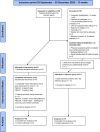Diet-induced ketosis in adult patients with subacute acquired brain injury: a feasibility study
- PMID: 38571572
- PMCID: PMC10990248
- DOI: 10.3389/fmed.2023.1305888
Diet-induced ketosis in adult patients with subacute acquired brain injury: a feasibility study
Abstract
Background: Research in animal models on cerebral metabolism after brain injury highlights the potential benefits of ketosis in reducing secondary brain injury, but studies in humans are lacking.
Aim: This study aimed to examine if a 6-week ketogenic diet intervention with added medium-chain triglycerides (MCT) was feasible in adult patients with acquired brain injury in the subacute phase, whether ketosis could be achieved and maintained, and to what extent serious adverse reactions, adverse reactions, serious adverse events, and adverse events occured.
Methods: Patients ≥18 years of age diagnosed with subacute acquired brain injury and an expectation of hospitalisation ≥6 weeks were included in the intervention group. Patients not included in the intervention group were included in a standard care reference group. The intervention consisted of a ketogenic diet supplemented with MCT to obtain a plasma concentration of β-hydroxybutyrate (BHB) ≥0.5 mmol/L. Patients who were enterally fed were given KetoCal® 2.5:1 LQ MCT Multi Fiber (Nutricia A/S, Allerød, Denmark), supplemented with Liquigen® (Nutricia A/S, Allerød, Denmark). Patients consuming oral nutrition were given KetoCal® 2.5:1 LQ MCT Multi Fiber supplemented with Liquigen®, in addition to ketogenic meals.
Results: During a 13-week inclusion period, 12 of 13 eligible patients (92% [95% CI: 67% to 99%]) were included in the intervention group, and 17 of 18 excluded patients (94% [95% CI: 74% to 99%]) were included in the reference group. Eight patients (67%) completed the 6-week intervention. It took a median of 1 day to achieve ketosis from starting a 100% MCT ketogenic diet, and it was maintained for 97% of the intervention period after ketosis was obtained. There were no serious adverse reactions to the MCT ketogenic diet, and patients experienced adverse reactions not considered serious in 9.5% of days with the intervention. The MCT ketogenic diet was accepted by patients on all intervention days, and in the two patients transitioning from enteral feeding to oral intake, there were no complications related to transitioning.
Conclusion: Intervention with MCT ketogenic diet is feasible and tolerated for 6 weeks in hospitalised adult patients with subacute acquired brain injury. Randomised controlled trials are needed to assess the benefits and harms of the MCT ketogenic diet and the effect on patients' recovery.Clinical trial registration: ClinicalTrials.gov, identifier [NCT04308577].
Keywords: acquired brain injury (ABI); ketogenic diet (KD); ketosis; medium-chain triglycerides (MCT); stroke; subarachnoid haemorrhage (SAH); traumatic brain injury (TBI); β-hydroxybutyrate (BHB).
Copyright © 2024 Edwards, Andersen, Curtis, Riberholt and Poulsen.
Conflict of interest statement
The remaining authors declare that the research was conducted in the absence of any commercial or financial relationships that could be construed as a potential conflict of interest.
Figures


Similar articles
-
Exploring diet-induced ketosis with exogenous ketone supplementation as a potential intervention in post-traumatic stress disorder: a feasibility study.Front Nutr. 2024 Oct 31;11:1406366. doi: 10.3389/fnut.2024.1406366. eCollection 2024. Front Nutr. 2024. PMID: 39588043 Free PMC article.
-
Inducing ketogenesis via an enteral formulation in patients with acute brain injury:a phase II study.Neurol Res. 2020 Apr;42(4):275-285. doi: 10.1080/01616412.2019.1709743. Epub 2020 Feb 26. Neurol Res. 2020. PMID: 32098578 Clinical Trial.
-
A Modified MCT-Based Ketogenic Diet Increases Plasma β-Hydroxybutyrate but Has Less Effect on Fatigue and Quality of Life in People with Multiple Sclerosis Compared to a Modified Paleolithic Diet: A Waitlist-Controlled, Randomized Pilot Study.J Am Coll Nutr. 2021 Jan;40(1):13-25. doi: 10.1080/07315724.2020.1734988. Epub 2020 Mar 26. J Am Coll Nutr. 2021. PMID: 32213121 Free PMC article. Clinical Trial.
-
The possibility of use of the ketogenic diet and medium chain triglycerides supplementation in the support therapy of Alzheimer disease.Curr Opin Clin Nutr Metab Care. 2021 Jul 1;24(4):385-391. doi: 10.1097/MCO.0000000000000752. Curr Opin Clin Nutr Metab Care. 2021. PMID: 33741752 Review.
-
The Ketogenic Diet and Alzheimer's Disease.J Nutr Health Aging. 2022;26(6):606-614. doi: 10.1007/s12603-022-1807-7. J Nutr Health Aging. 2022. PMID: 35718870 Review.
Cited by
-
β-hydroxybutyrate and ischemic stroke: roles and mechanisms.Mol Brain. 2024 Jul 29;17(1):48. doi: 10.1186/s13041-024-01119-0. Mol Brain. 2024. PMID: 39075604 Free PMC article. Review.
-
Mitochondria: the hidden engines of traumatic brain injury-driven neurodegeneration.Front Cell Neurosci. 2025 May 9;19:1570596. doi: 10.3389/fncel.2025.1570596. eCollection 2025. Front Cell Neurosci. 2025. PMID: 40417416 Free PMC article. Review.
References
-
- Institute for Health Metrics and Evaluation (IHME). Global burden of disease study (2019). Global burden of disease collaborative network Seattle, United States Available at: http://ghdx.healthdata.org/gbd-results-tool
-
- James SL, Theadom A, Ellenbogen RG, Bannick MS, Montjoy-Venning W, Lucchesi LR, et al. . Global, regional, and national burden of traumatic brain injury and spinal cord injury, 1990–2016: a systematic analysis for the global burden of disease study 2016. Lancet Neurol. (2019) 18:56–87. doi: 10.1016/S1474-442(18)30415-0, PMID: - DOI - PMC - PubMed
-
- Vos T, Lim SS, Abbafati C, Abbas KM, Abbasi M, Abbasifard M, et al. . Global burden of 369 diseases and injuries in 204 countries and territories, 1990–2019: a systematic analysis for the global burden of disease study 2019. Lancet. (2020) 396:1204–22. doi: 10.1016/S0140-6736(20)30925-9, PMID: - DOI - PMC - PubMed
Associated data
LinkOut - more resources
Full Text Sources
Medical

